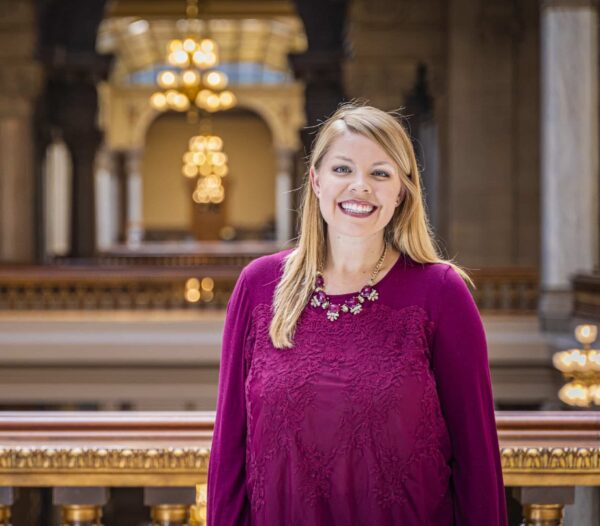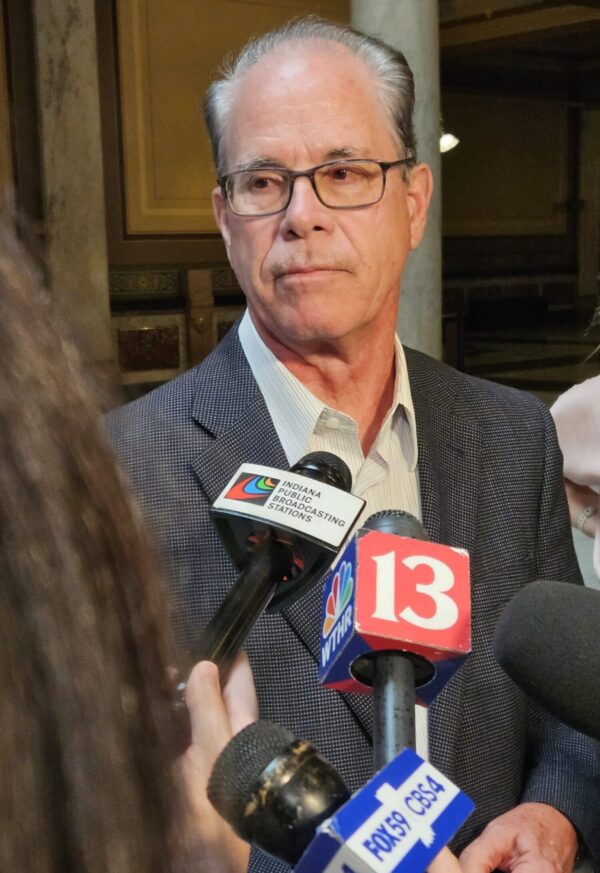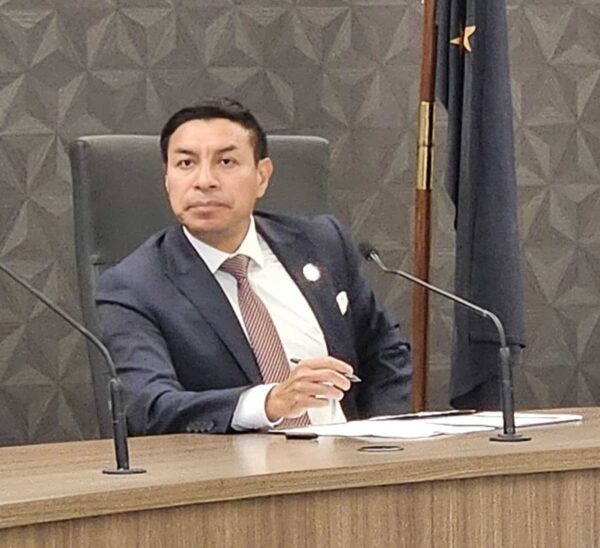
Marilyn Odendahl
The Indiana Citizen
October 17, 2025
A new poll shows a majority of Hoosier voters have an unfavorable opinion of their elected officials and think Indiana is headed in the wrong direction, but one political expert described the discontent as “par for the course.”
The poll, conducted in early October by North Star Opinion Research, found 53% of Indiana voters think the state is on the wrong track. Moreover, 43% hold an unfavorable view of Gov. Mike Braun and 53% say they are dissatisfied with the candidates they have to choose from in state elections.
Independent Indiana, a nonpartisan initiative established in 2025 to support and promote independent candidates for elected office, commissioned the poll.

Laura Merrifield Wilson, associate professor of political science at the University of Indianapolis, sees the poll’s results as reflecting typical voter behavior. Namely, the assessment Hoosier voters make about a candidate during an election will change once that person takes office. That shift is exacerbated by the state’s low turnout at the ballot box and voters’ unfamiliarity with the individuals running.
“When you’re talking about state level offices, specifically the state legislative races, these are oftentimes candidates and incumbents that voters aren’t familiar with,” Merrifield Wilson said. “Voters don’t know who their person is, what district they live in, voting record or anything like that. So there is a real disconnect between the assessment of a current elected official … (and voters’) actual behavior at the polls.”
A predictor of voters’ perceptions was party affiliation. The poll found that 63% of Republicans thought Indiana is headed in the right direction, but only 28% of Independents and 15% of Democrats agreed. Likewise, 68% of Republicans were satisfied with the choices of candidates in Indiana elections compared with 32% of Independents and 27% of Democrats.
The poll also asked about mid-decade redistricting. Since August, Braun and Republican state legislators have been under pressure from the Trump administration to redraw Indiana’s congressional district map this year. The goal is to give Republican candidates an advantage, so they can unseat the Democrats in the 1st and 7th districts in the November 2026 midterm election and help the GOP retain control of the U.S. House of Representatives.
Although Vice President JD Vance has traveled to Indiana twice to speak with Republican lawmakers, the supermajority has not embraced redistricting. Also, Braun, who likely would have to call the General Assembly into a special session to redistrict, has not used the gubernatorial bully pulpit to push legislators to reconfigure the congressional districts.
The apparent reluctance among elected officials was mirrored in the Independent Indiana poll with a majority of Indiana voters, 53%, saying they oppose mid-decade redistricting. However, while only 34% of voters said the maps should be redrawn, the level of support fluctuated according to the voters’ political affiliations with 59% of Republicans supporting redistricting compared with 28% of independents and 11% of Democrats.
To Nathan Gotsch, executive director of Independent Indiana, the poll’s findings show voters are frustrated with the state’s two-party system and the limited choices they have at the ballot box.
“These results show that Hoosiers are increasingly fed up with a system that limits competition and rewards extremism,” Gotsch said in a press release. “Redistricting is just the latest example, but it’s clear that voter frustration has been building for a long time.”
Merrifield Wilson said the secrecy surrounding the redistricting fight is fueling voters’ dissatisfaction with their elected leaders. The conversations among Republican legislators about redoing the maps are taking place behind closed doors, so that, she said, Hoosiers are “at the mercy of guessing” what is happening.
Voters have little information about what lawmakers are doing and how they feel about redistricting, so that can amplify the negative assessment many Hoosiers may already have of elected officials, Merrifield Wilson said.
Even so, Merrifield Wilson said redistricting could provide Braun with an opportunity to burnish his legacy as governor.

The poll found just 24% of Hoosier voters had a favorable opinion of Braun. Among Republicans, 53% approved of his job performance, but that was dwarfed by the 90% of Republicans who gave President Donald Trump a favorable rating. Comparatively, just 15% of Independents and only 8% of Democrats had a favorable assessment of the governor.
Despite his troublesome approval rating, Merrifield Wilson said Braun can benefit from time. The governor is still in the first year of his first term, so he has three more years to recover and garner more public support before he has to face Hoosier voters in the 2028 election.
However, Merrifield Wilson said Braun could be forever linked to redistricting much like former Gov. Eric Holcomb is tied to the mandates he imposed during the COVID pandemic. As the White House has been twisting arms over redistricting, the legislature continues to grapple with this decision, because, she said, lawmakers recognize they will be taking a big risk by redistricting without getting any tangible benefit in return. This has now become a moment that has captured the public’s attention and Hoosiers are watching to see how Braun responds, she said.
“This is something where you say, ‘OK, where’s your loyalty, where’s your priority,” Merrifield Wilson said. “I think this will tell us a lot about the governor in terms of what he chooses to do or, ultimately, what he chooses not to do.”
Deciding not to redistrict could improve Braun’s favorability rating, Merrifield Wilson said, but any bump might be short-lived. Braun will need to build and maintain an amiable relationship with the General Assembly to get his agenda through, which, she speculated, will soon include health care. Turning his attention to health care could earn him some points with voters, especially since some Hoosiers could be slapped with skyrocketing premiums due to federal tax subsidies like those in the Affordable Care Act potentially expiring at the end of this year, she said.
Conversely, Braun’s numbers might tumble if the legislature focuses on social issues during the 2026 session, Merrifield Wilson said. Hot-button topics could inflame voters, who would likely turn their ire toward the governor.
“So the numbers could go up in terms of approval,” Merrifield Wilson said. “They might drop right back down.”
The approval rating for Indiana Secretary of State Diego Morales was extremely low across the political spectrum, highlighting a rare consensus among Hoosier voters, according to the poll. Overall just 5% of the voters polled had a favorable opinion of Morales while 57% said they had never heard of him. The breakdown by party showed a similar perception with only 7%, 4% and 6% of Republicans, Independents and Democrats, respectively, approving of Morales as an elected official.

Merrifield Wilson said Morales’ numbers might be stymied by voters not knowing what the secretary of state does. Still, as she noted, Morales does have “a lot of self-inflicted controversies” from hiring his brother-in-law, to buying a luxury car with taxpayer money, taking foreign trips without clarifying who paid for the travel and, most recently, spending “a lot of political capital, resources and time” to identify one potential noncitizen on the voter rolls.
However, an early political forecast by Sabato’s Crystal Ball gave Morales the edge in the 2026 Indiana secretary of state race.
“I think Morales is teeing up to be the candidate to watch, quite frankly, in this next election cycle,” Merrifield Wilson said. “He’s unpopular within his own party, in addition to, obviously, across the aisle. So the question is, for all these what I would consider to be self-inflicted controversies, would he be able to still overcome this cycle” and win next year’s election.
The Independent Indiana poll also weighed in on a few other issues. Regarding the popularity of the two main parties, only 33% of those polled had a favorable view of Republicans and just 25% thought favorably of Democrats. Also, the poll showed that 69% of voters overall thought the two-party system failed to adequately represent the view of most Hoosiers.
In addition, the poll found little support for straight-ticket voting, which enables Hoosiers to automatically vote for all the candidates in a particular party by checking one box on the ballot. Indiana is one of only six states that allows straight-ticketing voting, but Hoosier voters do not like it with 62% of those polled describing that kind of voting as a “bad thing.”
The poll included 604 registered voters who were surveyed during the first week of October. Of the respondents, 64% were interviewed on cell phones, 7% on landlines and 29% by text-to-web. Also, the respondents reflected the demographics of the state’s voter rolls in terms of region, gender, race, age and education level. The poll has a margin of error of plus or minus 3.99 percentage points.
Dwight Adams, an editor and writer based in Indianapolis, edited this article. He is a former content editor, copy editor and digital producer at The Indianapolis Star and IndyStar.com, and worked as a planner for other newspapers, including the Louisville Courier Journal.
The Indiana Citizen is a nonpartisan, nonprofit platform dedicated to increasing the number of informed and engaged Hoosier citizens. We are operated by the Indiana Citizen Education Foundation, Inc., a 501(c)(3) public charity. For questions about the story, contact Marilyn Odendahl at marilyn.odendahl@indianacitizen.org.